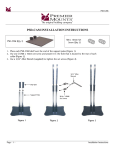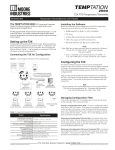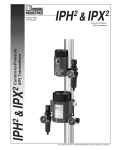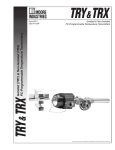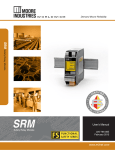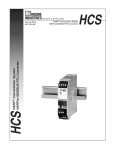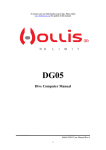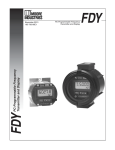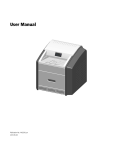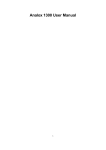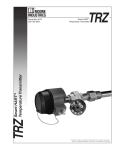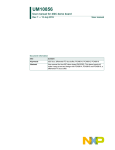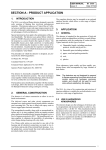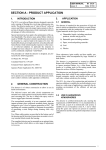Download PSD user`s Manual - Moore Industries International
Transcript
No. 178-717-00M June 2018 PC-Programmable Loop Display PSD Demand Moore Reliability Customer Support Moore Industries is recognized as the industry leader in delivering top quality to its customers in products and services. We perform a sequence of stringent quality assurance checks on every unit we ship. If any Moore Industries product fails to perform up to rated specifications, call us for help. Our highly skilled staff of trained technicians and engineers pride themselves on their ability to provide timely, accurate, and practical answers to your process instrumentation questions. Our headquarters and other facilities phone numbers are listed below. There are several pieces of information that can be gathered before you call the factory that will help our staff get the answers you need in the shortest time possible. For fastest service, gather the complete model and serial number(s) of the problem unit(s) and the job number of the original sale. Locations World Headquarters Europe Australia 16650 Schoenborn Street North Hills, California 91343-6196, U.S.A. Tel: (818) 894-7111 Fax: (818) 891-2816 E-mail: [email protected] TOLL FREE: 1-800-999-2900 1 Lloyds Court, Manor Royal, Crawley W. Sussex RH10-9QU United Kingdom Tel: 01293 514488 Fax: 01293 536852 FREE PHONE: 0800 525107 [email protected] www.miinet.com/uk Sydney, NSW 3/1 Resolution Drive Caringbah, New South Wales 2229 Australia Tel: (02) 8536-7200 Fax: (02) 9525-7296 [email protected] www.miinet.com/au Guido Gezellestraat 106 BE-2630 Aartselaar Belgium Tel: 03/448.10.18 Fax: 03/440.17.97 [email protected] Dutch: www.miinet.com/dbe French: www.miinet.com/fbe Perth, WA 6/46 Angove Street North Perth, Western Australia 6006 Australia Tel: (08) 9228-4435 Fax: (08) 9228-4436 [email protected] www.miinet.com/au www.miinet.com China Room 402, No. 57, Lane 651, Xipu Road, Xinqiao Town, Songjiang District, Shanghai, 201612, P. R. China Tel: 86-21 62491499 Fax: 86-21 62490635 E-mail: [email protected] www.miinet.com/cn Burg Meslaan 98 4003 CD Tiel The Netherlands Tel: (0)344-617971 Fax: (0)344-615920 [email protected] www.miinet.com/nl www.miinet.com www.miinet.com Moore Industries-International, Inc. Table of Contents Introduction.............................................................................................................................................. 5 The PSD........................................................................................................................... 5 Model and Serial Numbers............................................................................................. 5 Specifications.................................................................................................. 5 Dimensions...................................................................................................... 6 Configuring the PSD....................................................................................... 8 Installing the Configuration Software........................................................................... 8 Using the PC Program.................................................................................................... 9 Connecting the PSD to PC............................................................................ 10 Necessary Equipment Table......................................................................................... 10 Square Roots and the Curve Generator...................................................... 11 Programming the PSD.................................................................................. 13 Site-Viewing the Configuration.................................................................................... 14 Installation...................................................................................................... 14 Recommended Ground Wiring Practices.................................................................... 14 Electrical Connections................................................................................................. 14 CE Conformity............................................................................................................... 15 Operation....................................................................................................................... 15 Maintenance.................................................................................................................. 13 Intrinsic Safety............................................................................................... 16 Installation in Hazardous Locations............................................................ 18 Specific Conditions for Safe Use ................................................................. 19 Appendix - A PSD in Safety Instrumented Systems....................................... 21 PSD Introduction The PSD The PSD is a 2-wire (loop-powered), PC-programmable loop display. Typically paired with one of our extensive line of durable housing and enclosure options, its size, accuracy, and low voltage drop make it the ideal solution for displaying measurements in remote or otherwise difficult-toaccess locations or nearly overburdened loops. This is the user’s manual for the PSD, Moore Industries’ PC-Programmable Loop Display. It contains all of the information needed to configure, install, operate and maintain the PSD. The following guidelines are used in this manual: WARNING - Hazardous procedure or condition that could injure the operator. Caution - Hazardous procedure or condition that could damage or destroy the unit. Note - Information that is helpful for a procedure, condition or operation of the unit. Model and Serial Numbers Moore Industries uses the model and serial numbers of our instruments to track information regarding each unit that we sell and service. If a problem occurs with your instrument, check for a tag affixed to the unit listing these numbers. Supply the Customer Support representative with this information when calling. Specifications Performance Input Accuracy: ±0.012% of input scale Overall Accuracy: The overall accuracy of the unit is the input accuracy. (±0.012% of input scale) It includes the combined effects of linearity, hysteresis, repeatability, and adjustment resolution. It does not include ambient temperature effect. Stability: Error is in % of maximum span Stability Performance (Continued) Excitation Current: ≥3.8mA Burden: <2.3VLP (<5.1VLP when –LMD option is installed and the PSD is disconnected from the loop) Display Type: LCD; Top Row, 10mm (0.4 inch) high black digits on a reflective background; Bottom Row, 6mm (0.23 inch) high black digits on a reflective background Display Update Rate: 100msec Format: Top row is five alphanumeric characters plus sign and decimal point; Bottom row is five alphanumeric characters Range: -99999 to 99999 Minimum Display Span: 1.00 Input to Output 1yr 3yrs 5yrs mA 0.08 0.14 0.18 Resolution: 0.0028% of input scale Over-Current Protection: 100mA maximum Input Overrange: 24mA Digital Input Filter: User-programmable; 50 or 60 Hz Ambient Conditions Operating Range: -25°C to 85°C (-13°F to 185°F) Ambient Storage Range: Conditions -45°C to 85°C (Continued) (-49°F to 185°F) Relative Humidity: 0-95%, non-condensing Ambient Temperature Effect: ±0.015% of span per °C change, maximum RFI/EMI Immunity: 20 V/m when tested according to SAMA 33.1 abc with 0.5% of span or less error; 20 V/m @ 80-1000MHz, 1KHz AM, when tested according to IEC1000-4-3-1995 Common Mode Rejection: 100dB @ 60Hz Normal Mode Rejection: 30dB @ 60Hz Weight BH housing: 1.37 kg (3 lbs, 1.1 oz) D2LC housing: 640g (1 lb, 6.3 oz) HP-style housing: 150g (5.3 oz) Specifications and Information subject to change without notice. Demand Moore Reliability 5 PSD Ordering Information Unit Input Output Power PSD 2.3VLP 4-20MA PRG PCLoop Program- Loop Program- Input Powered mable mable with supLoop plied conDisplay figuration software to display a percent or any other EGU of up to 5 characters in length. Options -LMD Loop Maintenance Zener Diode provided at input terminals allowing the PSD to be removed from the loop without interrupting loop continuity (Burden: increases from <2.3 to <5.1VLP when PSD is removed from the loop) -ISC: CSA Approved Intrinsically-Safe & Non-Incendive -ISE: ATEX Approved Intrinsically-Safe -ISF: FM Approved Intrinsically-Safe & Non-Incendive -VTD: Standard Factory Calibration with NIST Test Data Report Housings BH2NG* (*) or (‡) Aluminum 2-Hub, Explosion-Proof enclosure with two, ½-inch NPT entry ports and a glass cover BH2TG* (*) or (‡) Aluminum 2-Hub, Explosion-Proof enclosure with two, ¾-inch NPT entry ports and a glass cover BH2MG* (*) or (‡) Aluminum 2-Hub, Explosion-Proof enclosure with two, M20 x 1.5 entry ports and a glass cover BH3NG* (*) or (‡) Aluminum 3-Hub, Explosion-Proof enclosure with three, ½-inch NPT entry ports and a glass cover BH3TG* (*) or (‡) Aluminum 3-Hub, Explosion-Proof enclosure with two, ¾-inch NPT side-entry ports, one ½-inch NPT bottom-entry port, and a glass cover BH3MG* (*) or (‡) Aluminum 3-Hub, Explosion-Proof enclosure with two, M20 x 1.5 side-entry ports, one ½-inch bottom-entry port, and a glass cover D1LC 1-Hub, Low base, Clear cover, NEMA 4X (IP66) enclosure D2LC 2-Hub, Low base, Clear cover, NEMA 4X (IP66) enclosure HP Hockey-puck housing and spring clips DN Snap-in mounting for HP case on TS-32 DIN rail FL Mounting flanges on HP suitable for relay track or screw mounting FLD Mounting flanges on HP suitable for 3½” relay track or screw mounting SB2NG* (*) or (‡) 316 Stainless Steel 2-Hub, Explosion-Proof enclosure with two, ½-inch NPT entry ports and a glass cover SB2MG* (*) or (‡) 316 Stainless Steel 2-Hub, Explosion-Proof enclosure with two, M20 x 1.5 entry ports and a glass cover * Either A or E suffix (comes supplied with 2” pipe mount hardware) A suffix indicates ANZEx/TestSafe (Ex d) Flameproof approvals (i.e. BH2MGA) E suffix indicates ATEX (Ex d and tb) Flameproof approvals (i.e. BH2MGE) ‡ P suffix indicates enclosure comes equipped with base plate and U-bolts for mounting on a 2-inch pipe (i.e. BH2NGP) See BH, SB and D-BOX Datasheets for additional information. To order, specify: Unit / Input / Output / Power / Options [Housing] Model Number Example: PSD / 4-20MA / PRG / 2.3VLP / -LMD [BH2NG] 6 Demand Moore Reliability PSD Figure 1. PSD Explosion-Proof BH Enclosure Dimensions PSD 602.78 MMETR +IN -IN VIEW Figure 2. PSD Hockey-Puck Dimensions 76mm (3.00 in) 66mm (2.58 in) PSD 602.78 MMETR 83mm (3.25 in) 61mm (2.4 in) 18mm (.70 in) 62mm (2.45 in) +IN -IN VIEW 43mm (1.70 in) 64mm (2.50 in) FRONT VIEW SIDE VIEW Demand Moore Reliability 7 PSD Figure 3. Field-Mount, NEMA 4X/IP66 D-BOX Enclosure Dimensions Conduit Fitting 130 mm (5.12 in) 116 mm (4.56 in) 118mm (4.65 in) 112mm 64mm (4.40 in) (2.50 in) 83mm (3.25 in) Body Bezel Cover Interior Diameter 81mm (3.2 in) Instrument Tag CL 84mm (3.30 in) 8 Demand Moore Reliability 27mm (1.05 in) PSD Configuring the PSD One of the benefits of the PSD is that it has no internal or external controls to adjust or settings to change. All operating parameters are set using Moore Industries’ Intelligent PC Configuration software. Once these software settings are made, they are downloaded to the instrument in the form of a Configuration File and stored in the unit’s non-volatile memory. You can choose to save a backup copy of the file on your PC hard drive or other external media. The transmitter communicates with the PC through a cable connection to the PC’s serial (COM) port or optional USB cable. The serial cable is P/N 803-040-26 and the USB cable is P/N 804-030-26. No PSD Required It is not necessary to connect the display to a PC while creating configuration files using the Configuration Software. The Configuration Program can be run without connecting a PSD, and most operating parameters can be set without benefit of an attached unit. This makes it easy to create a set of operating parameters, save and download them to one or more transmitters at a later time. The PSD must be connected to the PC in order to: capture input, assign a tag, receive (via download) a configuration file and save the configuration file from the instrument’s memory. Installing the Configuration Software Refer to Table 1 for the equipment needed. 1. Insert the Moore Industries Interface Solution PC Configuration Software CD into the CD drive of the PC. Access the CD and open the PSD SPD PC Configuration Software folder. 2. Double-click the installation program located in the folder. Follow the prompts to correctly install the program. Once the Configuration Program is installed on the PC, the PSD can be connected to the loop or to equipment to simulate and calibrate input. You can then view and/or change the instrument’s parameters. Default/Factory Configurations The following are the default factory settings for your unit: Input: - 4-20mA - Filter: 60Hz - Damping Time: 0.0 Display: - 0-100 PCT - Display Resolution: AUTO - Linearization Mode: Normal Demand Moore Reliability 9 PSD Figure 4. Most of the PSD Operating Parameters can be set from the Main Screen of the Configuration Program. 2 1 6 3 4 8 7 5 Using the PC Program The PSD PC Configuration Software is used to program all of the PSD’s parameters. The PC Software is made up of these sections: 1. Arrow Buttons–Three Arrows here are used for Downloading to Unit (down Arrow), Uploading from Unit (Up Arrow),or Get Set-up (Right Arrow). Note: After uploading file (by pressing the Up Arrow), you must press the Right Arrow button to populate all information into the configuration dialog area. 2. Status–This portion of the screen displays the activity of the connected unit. It will show you if the unit is Idle, Uploading, Downloading, or Monitoring. 3. Process Variables–This displays two variables: the loop signal in mA and the loop signal after the PSD has converted it to the designated EGU. 4. Input Settings, Output Setings, Tag, and Device– These three sections display the configuration of the connected PSD. 10 Demand Moore Reliability 5. Connection–Check this section to track the status of the PC’s connection with the PSD. 6. Input/Output & Custom Curve Tabs–Displays all the information to program the PSD with either a standard, linear curve (Input / Output), or with a custom linearization curve (Custom Curve). 6. Input Configuration–Displays the input settings proposed for the transmitter. The two different capture buttons permit you to capture the input span. 7. Display Configuration–Shows the display settings proposed for the PSD. 8. Engineering Units (EGU), Linearization Mode, Filter, Display Resolution, and Damping Time–This set of radio buttons and edit boxes allow you to input different values proposed for transmission to the PSD. PSD Connecting the PSD to PC It is recommended that the PSD be installed in the loop before it is configured so that you can use the input capture feature to capture the exact full and zero values of the loop. See Figure 5 for a hookup diagram, and Table 1 for a list of necessary equipment. If it is not possible to hookup the PSD to the loop, you can also use a variable current source and an ammeter or multimeter to setup your unit before you install it on the loop. See Figure 6 for a hookup diagram, and Table 1 for a list of necessary equipment. The PC Configuration Software can program and save the settings for the PSD without having a PSD attached, but you do need to attach the PSD as shown below in order to download information. Caution: Unplugging the programming cable or resetting power while downloading to the unit could result in a default configuration / calibration and the unit may have to be returned to the factory. Table 1. Assembling the necessary equipment. Device Specifications Multimeter or Ammeter (optional) Accurate to ±0.025% of span Variable Current Capable of 4-20mA; accurate to ±0.01% Source of span Microsoft Windows-based PC; 16Mb free RAM; 20Mb free disk space Personal Computer on hard drive 1 (one) serial port or one USB port (with optional cable) PC Operating ® System Microsoft Windows XP, 7 or 10 Moore Industries Version 1.0 or higher, successfully PC Configuration installed onto the hard drive Software NOTE: 1. Terminal blocks can accommodate 14-22 AWG (2.08-0.33 mm2) solid wiring. 2. Tighten terminals to 4 In-lb (0.45 Nm), maximum. Figure 5. Connecting the PSD to a 4-20mA Loop PSD 602.78 DEG C OR +IN + -IN VIEW – To USB (COM) Port of PC + 4-20mA TRANSMITTER LOOP POWER SUPPLY – TO SERIAL (COM) PORT OF PC PSD CAUTION: DO NOT CONNECT THE LOOP POWER SUPPLY DIRECTLY TO THE PSD! A CURRENT LIMITING DEVICE SUCH AS A TRANSMITTER MUST BE IN THE LOOP! – + 803-040-26 FOR NON-ISOLATED CABLE 803-039-26 FOR ISOLATED CABLE or Optional USB Cable Part# 804-030-26* *When using Optional USB Cable Part# 804-030-26 please assure that the ground of the PSD is at the same potential as the PC that the usb cable is plugged in. Demand Moore Reliability 11 PSD Square Roots and the Curve Generator Moore Industries provides two options for customers who require a custom square root linearization table. You can either generate a custom curve table or import a pre-made curve. Option One: Generating a Custom Curve The first option is to run the Table Generator and generate a custom table that can be easily saved and imported into the Universal PC Configuration Software. To generate your own table, follow the instructions below. 1. From the START Menu, click on PROGRAMS, MOORE INDUSTRIES, then CURVE GENERATOR. The program that is shown below will appear. Figure B-1. The Square Root Curve Generator program will allow you to easily create any custom square root curve that you need. 2. Enter the values for the input and display into the appropriate boxes. Enter the number of linearization points that you would like generated into the NUMBER OF LIN. POINTS box. 3. Click on GENERATE to create the table, then enter the name you would like the table saved as. 4. Close the Curve Generator and open the Universal PC Configuration Software. Click on the FILE menu, then on IMPORT CUSTOM CURVE. Select the “view all files” on the OPEN dialog box, then find the file name that you just saved. 5. Verify all settings. 6. Use the download button to transmit the new file to the PSD and finish the process. Option Two: Importing a Pre-made Curve The second option is to use a pre-made custom curve table that will work the function. To import the file, follow the instructions below. 1. In the Universal PC Configuration Program, click on the FILE menu, then on IMPORT CUSTOM CURVE. Select the “view all files” on the OPEN dialog box, then navigate to the location in the filesystem of the custom curve of interest and click OPEN. The Universal PC Configuration Software will import the file. 2. Verify all settings. 3. Use the download button to transmit the new file to the PSD and finish the process. 12 Demand Moore Reliability PSD Figure 6. Connecting the PSD to configuration equipment TO SERIAL (COM) PORT OF PC PSD PSD 602.78 OR DEG C +IN AMMETER OR MULTIMETER + -IN VIEW To USB (COM) Port of PC – – + – + ADJUSTABLE CURRENT SOURCE 803-040-26 FOR NON-ISOLATED CABLE 803-039-26 FOR ISOLATED CABLE or Optional USB Cable Part# 804-030-26* *When using Optional USB Cable Part# 804-030-26 please assure that the ground of the PSD is at the same potential as the PC that the usb cable is plugged in. Programming the PSD There are two sections for programming the PSD – “Input/Output,” and “Custom Curve”. The Input/ Output tab allows you to program the PSD with a normal, linear curve; the “Custom Curve” allows you to program the PSD with a custom linearization curve. Programming the PSD with a Normal (linear) Curve It is a simple process to program the PSD with a normal curve. Using the “Input/Output” tab, you will need to adjust the following settings. 1. In the “Input Settings” box, enter the Zero and Full Input values, or click the “Capture” buttons (this is the preferred method) and adjust the input. 2. Go to “Display Settings” and input the range you would like displayed on the PSD’s screen. 3. Enter a name for the unit (to be read by the PC Program) in the “Tag” box. 4. Enter into the “EGU” box the engineering unit you would like displayed. 5. “Linearization Mode” should be left at “Normal”. 6. Set the “Filter” to match the frequency of the filter for the AC power mains in your country. 7. Set the “Display Resolution” to the number of decimal points you would like the PSD to display. 8. Smooth out input variations by increasing the Damping Time. 9. Download the new settings to the instrument by attaching the instrument to the PC and clicking on the download button. Programming the PSD with a Custom Curve There are a variety of ways to program the PSD with a custom curve. You can import a comma-delimited table that you have written in another program (for example, design the table in Microsoft® Excel and save it as .csv type). You can import a ready-made file that came with your configuration software (such as the square root table). Or, you can set your own custom curve by follwing the directions described below. 1. Set the “Linearization Mode” to “Custom”. In the “Linearization Data” box, enter the number of linearization points. Then, in the “X data” column of the table, enter the value of the loop input in mA. In the “Y data” column of the table, enter the corresponding EGU value that you would like displayed. Do this for each point of your custom curve. It may be useful to use the buttons in the “Commands” box to work with the custom curve table cells. 2. Set the “Input Settings” to the span of the loop you will be reading. 3. Set the “Display Settings” to the span that you would like to have displayed. This allows you to reset the range of the display with one step instead of needing to recalculate the entire custom curve table. 4. Click on the “Input/Output” tab so that you can set the Filter, Display Resolution, and Damping Time to the appropriate values. 5. Download the new settings to the instrument by attaching the instrument to the PC and clicking on the download button. Demand Moore Reliability 13 PSD Site-Viewing the Configuration Even after your PSD has been installed in the field, it is easy to verify its configuration using the frontmounted View button. Figure 7 describes the various displays controlled by the View button. Figure 7. The View button on the front of the PSD allows you view the different PSD settings. Installing the PSD in your loop involves mounting and making electrical connections. Recommended Ground Wiring Practices Moore Industries recommends the following ground wiring practices: • Any Moore Industries product in a metal case or housing should be grounded. Front Panel Push Button VIEW Installation VIEW MENU VIEW current settings Meter Mode: The display flashes Meter Mode, then displays the monitored input value in mA. VIEW Input Zero Value: Displays the lower range of the input value. VIEW Input Full Value: Displays the upper range of the input value. VIEW Normal/Custom Mode: Shows whether the PSD is in Custom Mode or Normal Mode. VIEW Exit View Mode: Returns to normal process display. • The protective earth conductor must be connected to a system safety earth ground before making any other connections. • All input signals to, and output signals from, Moore Industries’ products should be wired using a shielded, twisted pair wiring technique. Shields should be connected to an earth or safety ground. • For the best shielding, the shield should be run all the way from the signal source to the receiving device. (see Note below) • The maximum length of unshielded input and output signal wiring should be 2 inches. Note: Some of Moore Industries’ instruments can be classified as receivers (IPT 2, IPX 2, etc.) and some can be classified as transmitters (TRX, TRY, etc.) while some are both a receiver and a transmitter (SPA 2, HIM, etc). Hence, your shield ground connections should be appropriate for the type of signal line being shielded. The shield should be grounded at the receiver and not at the signal source. Electrical Connections When installing any Moore Industries product, always follow all local regulations and standards for grounding, shielding, and safety. WARNING: Terminals on this unit may be connected to hazardous voltages. Before making ANY connections to this unit, always remove power from the loop instrument power terminals. or instrument power terminals. 14 Demand Moore Reliability PSD Installation Category All terminals are rated CAT I. Equipment Ratings The PSD does not generate hazardous voltages. it provides a low current input. WARNING: If this unit is used in a manner not specified by Moore Industries, the protection provided by the equipment may be impaired. CE Conformity Installation of any Moore Industries’ products that carry the CE marking must adhere to the guidelines in the Recommended Ground Wiring Practices section in order to meet the EN 61326 requirements set forth in the applicable EMC directive. Maintenance Moore Industries suggests a quick check for terminal tightness and general unit condition every 6-8 months. Always adhere to any site requirements for programmed maintenance. Customer Support If service assistance is ever required for an device in your application, refer to the back cover of this manual for the telephone numbers to Moore Industries’ customer service department. If possible, make a note of the model number of the unit before calling. For fastest assistance, have the following information available: serial number, the job number and purchase order number under which it was shipped. WARNING: If this unit is used in a manner not specified by Moore Industries, the protection provided by the equipment may be impaired. Operation Once installed and programmed, PSD displays begin to operate immediately. Depending upon environmental conditions, they can be expected to operate unattended for extended periods of time. Demand Moore Reliability 15 16 Demand Moore Reliability 6- 5- (3) 4- (2) (1) KV E REVISION (3) +PS -PS CSA International FM (US NEC- 500) / ' lnstrinsically Safe Class I, Div. 1, Groups A-D (2) 4-20 mA Intrinsically Safe Loop Transmitter or other associated apparatus Vmax or Ui = 30 VDC lmax or Ii = 110 mA Pmax or Pi = 0.65 W Ci = 0 nF Li = 0 µH Ca or Co � Ci + Ccable La or Lo � Li + Lcable Vmax or Ui � Voe or Vt lmax or Ii � lsc or It PSD Entity Parameters (VDC Supply) CB T. Code: T4@ 85°C Maximum Operating Ambient Temperature Range: -40 °C :!i Tamb. :!i +85°C This device must be agency approved (CSA, FM, etc.) as Intrinsically Safe. The 'COM Port' and the 'View Switch' Must Not be used In Hazardous 'Classified' Locations lnstrinsically Safe Class I, II, Ill; Div. 1; Groups A-G ' / the written consent of an authorized officer of MIi. ECO 18114 Hazardous (Classified) Location/Area FM lntrinsicall Safe PSD: PC-Programmable Loop Display NONE w_ Apparatus which is unspecified except that it must not be supplied from, or contain under normal or abnormal conditions a source of potential with respect to earth in excess of 250 VRMS or 250 VDC which is considered to be the Safe Area's maximum voltage. The Barrier or other Associated Apparatus must be approved by the "specific" (CSA/FM, etc.) certifying agency for I.S. connections. The output voltage '24 VDC :!i (Voe, Vt or Vo) :!i 30 VDC' & the output current (lsc, It or lo) must not exceed 110 mA. Also, it must be installed per the manufacturer's guidelines. The combined Capacitance and Inductance of the inter-connecting cables and the PC Prog. Transmitters must not exceed the values indicated on the Associated Apparatus. For FM applications, installation must be in accordance to 'ANSI-P12.6' (Installation of I.S. Systems for Hazardous 'Classified' Locations) and the National Electric Code 'ANSI/NFPA 70'. For CSA applications, adhere to the 'Canadian Electric Code C22.1' most current publication on I.S. installation guidelines. For CENELEC/ATEX applications, adhere to 'EN 60079-14' or any equivalent, most current and pertaining publication on I.S. installation guidelines. Warning: Substitution of components may impair the Intrinsic Safety of the unit. DO NOT open the unit when either energized or if an explosive gas atmosphere is present. Disconnect power before servicing. Also read, understand and adhere to the manufacturer's installation and operating procedures. The maximum power parameters of the COM port (to be used only in safe/non-hazardous areas) are: Vmax = 3.0 VDC, lmax = 300 µA, Pmax = 240 µW. Notes: 100-100-55 This page contains the installation diagram for the PSD carrying the intrinsically safe option (FM/CSA). It also includes guidelines for setting up zener barriers necessary in these types of applications. Ground Path Resistance Must Not Exceed 1 n Linear or Active Barrier DRAWING NUMBER Intrinsic Safety (1) Unspecified Apparatus Non-Hazardous (Safe) Area This is a controlled 'Related' or 'Schedule' drawing. No modifications are permitted without the notification and final approval of the Certification Engineer (related dwgs.) or the Certifying Agency (schedule dwgs.) Certified Product ITIIIMDORE INDUSTRIES Field Installation Diagram PSD [HP] Intrinsically Safe System CONTROL DRAWING CATEGORY Gus H . E li as DATE BY APPROVAL REVISED BY o 9t oo TiTLE 1--�� _ _ _ _ _ _ __ _ _ _ CHECKED 1111 Ho o 9t oo �--=___ _ _ --1 _ _ ENGINEER NOTICE RE PROPRIETARY INFORMATION: This drawing and the information Gus H. Eli as 09100 contained herein are the proprietary property of Moore Industries International, SCALE For Hazardous 'Classified' Locations Inc. (MIi} and should not be reproduced or disclosed to any third party without DRAWN DO NOT SCALE DRAWING PSD These diagrams must be used to augment the installation instructions earlier in this manual for units that are to operate in areas requiring intrinsically safe instrumentation. 6- (3) 45- (2) (1) Ground Path Resistance Must Not Exceed 1 n (2) 09/16 09/16 TITLE (3) +PS -PS ATEX / ' 9116 KV BY This device must be agency approved (CSA, FM, LCIE, etc.) as Intrinsically Safe. Vmax or Ui = 29.1 VDC lmax or Ii = 109 mA Pmax or Pi = 0.793 W Ci = 31.55 uF @ 6.2V Li = 0 µH Ri = 72.120 Ca or Co .!: Ci + Ccable La or Lo .!: Li + Lcable Vmax or Ui .!: Voe or Vt lmax or Ii .!: lsc or It Entity Parameters (VDC Supply) T. Code: T4@ 85°C Maximum Operating Ambient Temperature Range: -40 °C :S Tamb. :S +85 °C (2) 4-20 mA Intrinsically Safe Loop Transmitter or other associated apparatus Hazardous 'Classified' Locations The 'COM Port' and the 'View Switch' Must Not be used In maxiumum permittable cable capacitance 2.45uF Intrinsically Safe @ 111G Ex ia IIC T4 ' / ECO 18114 DATE A CB APPROVAL REVISION NOTICE RE PROPRIETARY INFORMATION: This drawing and the information contained herein are the proprietary property of Moore Industries International, Inc. (MIi} and should not be reproduced or disclosed to any third party without the written consent of an authorized officer of MIi. REVISED BY 100-100-85 Hazardous (Classified) Location/Area For Hazardous 'Classified' Locations (LCIE/ATEX Intrinsically Safe) Field Installation Diagram PSD/SLD -ISE [HP] lntrincisally Safe System PSD: PC Programmable Loop Display SLD: Functional Safety Loop Display NONE W. Tehan V. Garcia 09/16 DRAWING NUMBER Apparatus which is unspecified except that it must not be supplied from, or contain under normal or abnormal conditions a source of potential with respect to earth in excess of 250 VRMS or 250 VDC which is considered to be the Safe Area's maximum voltage. The Barrier or other Associated Apparatus must be approved by a "specific" certifying agency for I.S. connections. The output voltage '24 VDC :S (Voe, Vt or Vo) :S 29.1 VDC' & the output current (lsc, It or lo) must not exceed 109 mA. Also, it must be installed per the manufacturer's guidelines. The combined Capacitance and Inductance of the inter-connecting cables and the PC Prog. Transmitters must not exceed the values indicated on the Associated Apparatus. For CENELEC/ATEX applications, adhere to 'EN 60079-14' or any equivalent, most current and pertaining publication on I.S. installation guidelines. Warning: Substitution of components may impair the Intrinsic Safety of the unit. DO NOT open the unit when either energized or if an explosive gas atmosphere is present. Disconnect power before servicing. Also read, understand and adhere to the manufacturer's installation and operating procedures. The maximum power parameters of the COM port (to be used only in safe/non-hazardous areas) are: Vmax = 3.0 VDC, lmax = 300 µA, Pmax = 240 µW. Notes: (1) Linear or Active Barrier SCALE ENGINEER K.Darbey CONTROL DRAWING CATEGORY This page contains the installation diagram for the PSD carrying the intrinsically safe option (ATEX/). It also includes guidelines for setting up zener barriers necessary in these types of applications. Unspecified Apparatus Non-Hazardous (Safe) Area This is a controlled 'Related' or 'Schedule' drawing. No modifications are permitted without the notification and final approval of the Certification Engineer (related dwgs.) or the Certifying Agency (schedule dwgs.) Certified Product ITIIIMDORE INDUSTRIES CHECKED DRAWN DO NOT SCALE DRAWING PSD These diagrams must be used to augment the installation instructions earlier in this manual for units that are to operate in areas requiring intrinsically safe instrumentation. Demand Moore Reliability 17 PSD Installation in Hazardous Locations This section contain important information regarding the installation of the PSD in Hazardous Area Locations WARNING: Do not separate power connector when energized. WARNING: Substitution of components is not allowed, as it may impair the intrinsic safety. AVERTISSEMENT: La substitution de composants peut compromettre la sécurité intrinséque. WARNING: To prevent ignition of flammable or combustible atmospheres, disconnect power before servicing. AVERTISSEMENT: Risque d’explosion. Avant de déconnecter l’equipement, couper le courant ou s’assurer que débrancher tant que l’emplacement est désigné non dangereux. WARNING: Explosion Hazard. Do not disconnect equipment when a flammable or combustible atmosphere is present. AVERTISSEMENT: Risque d’explosion. Ne pas débrancher tant que le circuit est sous tension, a moins qu’il ne s’ agisse d’un emplacement non dangereux. Maximum operating parameters of the “COM” port for use in Non-Hazardous areas shall not exceed 3.0V, 300mA and 240mW 18 Demand Moore Reliability PSD Specific Conditions for Safe Use The following instructions must be adhered to when the PSD is used in hazardous locations and potentially explosive atmospheres. FM Installations Intrinsically Safe Applications Class I, II, III Division 1, Groups A-G The PSD shall be installed in compliance with the enclosure, mounting, spacing and segregation requirements of the ultimate application. Connections shall not be made to the communications “COM” port in Hazardous (Classified) Locations The maximum operating parameters fo the “COM” port for use in Non-Hazardous areas shall not exceed 3.0V , 300uA, and 240 uW. Nonincendive Applications Class I, Division 2, Groups A-D The PSD shall be installed in compliance with the enclosure, mounting, spacing and segregation requirements of the ultimate application. Connections shall not be made to the communications “COM” port in Hazardous (Classified) Locations. The maximum operating parameters fo the “COM” port for use in Non-Hazardous areas shall not exceed 3.0V , 300uA, and 240 uW. CSA Installations Intrinsically Safe Applications Class I, Division 1, Groups A-D The Model PSD must be installed per drawing No. 100-100-55 to be intrinsically safe. Connections shall not be made to the communications “COM” port in Hazardous (Classified Locations) The PSD is of open type unit Certified as a component for use only in other equipment where the suitability of the combination is to be determined by the authority having jurisdiction. Nonincendive Applications Class I, Division 2, Groups A-D Connections shall not be made to the communications “COM” port in Hazardous (Classified Locations) The PSD is of open type unit Certified as a component for use only in other equipment where the suitability of the combination is to be determined by the authority having jurisdiction. Demand Moore Reliability 19 PSD General Locations The PSD is of open type unit Certified as a component for use only in other equipment where the suitability of the combination is to be determined by the authority having jurisdiction. European Union Installations (ATEX 2014/34/EU Directive) Intrinsically Safe Applications II 1 G Ex ia IIC The model PSD is intrinsically safe. It can be used in potentially explosive atmospheres and can only be connect-ed to certified intrinsically safe associate equipment. This combination must be compatible with regards to intrinsic safety. The specific electrical parameters of the PSD model are: Ui : 29.1V; Ii : 109mA; Ri : 71.12Ohms; Pi : 793mW; *Ci : 31.55uF; Li : 0 *Ci : 31.55uF is given for Ui : 6.2V internally limited by voltage limiters. The electrical parameters of the certified associated intrinsically safe apparatus must not exceed any of the following values: Uo<=29.1VDC; Io<=109mA; Po<= 0.793W. The “COM” port and the “VIEW” switch must not be used in hazardous locations. The equipment must not be submitted to mechanical impacts or friction. Nonincendive, Type n Applications - Zone 2 II 3 G Ex nA IIC T4 The PSD shall be installed in compliance with the enclosure, mounting, spacing and segregation requirements of the ultimate application. Connections shall not be made to the communications “COM” port in Hazardous (Classified) Locations. The maximum operating parameters of the “COM” port for use in Non-Hazardous areas shall not exceed 3.0V , 300uA and 240uW. On installation the PSD shall be provided with supply transient protection external to the apparatus such that the voltage at the supply terminals of the PSD does not exceed 119V peak or 119Vdc. 20 Demand Moore Reliability PSD Appendix A - PSD in Safety Instrumented Systems The PSD is not intended for use as part of a Safety Function but can be considered ‘interference free’ when added to a safety critical loop for monitoring purposes. The PSD can be connected in 2 ways, either directly in the loop or with a Loop Maintenance Zener Diode (-LMD option) provided at input terminals allowing the PSD to be removed from the loop without interrupting loop continuity. (See Figures 1A & 1B). 602.78 VIEW + + The PSD is internally redundant at the field terminals. The only internal single faults that could possibly open the loop are solder joints and connectors. These are taken care of by the LMD option (Figure 1B), which is a zener diode attached to the bottom of the field terminal block. The only faults it cannot eliminate are the field connections themselves, where the field wires attach to the terminal block. PSD configuration 1B: Total = 11 FITs MMETR -IN The FMEDA (Failure Mode, Effects and Diagnostic Analysis) process only considers components of which failures could be reasonably considered to impact the safety function. This FMEDA considers only the input circuit of the PSD and how it may affect the safety critical loop it is connected to. The failure rate of the PSD instrument and function is not considered here. PSD configuration 1A: Total = 16 FITs PSD +IN Failure Rate Data + Safety DCS/ Logic Solver 4-20mA Transmitter Figure 1A. PSD Monitor in Safety Loop All of the above input circuit failures will result in the loop current changing outside its normal operating range (3.6-21.6 mA) which is assumed to be detected by the DCS/Logic solver. Failure Definitions A FIT, Failure in Time, is a unit measure for failures, indicating one failure per 1,000,000,000 (109) hours. A device failure is defined as a failure which causes any of the following: • The loop current to change by more than 2% • The output current to change outside its normal 3.6-21.6 mA operating range. PSD 602.78 MMETR +IN -IN VIEW + + Safety DCS/ Logic Solver + 4-20mA Transmitter Figure 1B. PSD Monitor with Loop Maintenance Diode option in Safety Loop A safe (S) failure is defined as a failure which causes: • The loop current to change outside its normal 3.6-21.6 mA operating range. A dangerous (D) failure is defined as a failure which causes: • The loop current to change by more than 2% AND the output current remains in normal 3.621.6 mA operating range. Demand Moore Reliability 21 PSD Methodology Assumptions This FMEDA is designed to provide the end user with sufficient information to construct a safety argument supporting the application of the subject device within a safety instrumented system (SIS). The FMEDA approach is consistent with the hardware requirements of IEC61508-2:2010. a. For the purpose of these assumptions ‘device’ will be taken to mean the ‘equipment’ which is the subject of this FMEDA. b. Only a single component failure will fail the entire ‘device’. c. Failure rates are constant; wear-out mechanisms are not included. d. Propagation of failures external to the device is not considered. e. All reasonably expected component failure modes are considered. f. The normal operating range of an analog transmitter is taken to be 3.6mA to 21.6mA. g. The reference ambient temperature is +40°C. h. The environmental profile is average for an industrial environment and can be compared to the Ground Benign classification of MIL-HDBK-217F and the reference environment of SN 29500 as well as Telcordia, HRD5, IEC 62380, RIAC 217+, among others. i. The input loop is a 4-20mA current loop. j. The input loop is monitored for excessively high and low loop current. In other words any out of range current will be detected as a fault. For full certification of the safety application, all requirements of IEC 61508 must be considered by the customer. The failure rate and modes used in the analysis for the PSD were calculated using the Exida FMEDA tool. This tool contains a proprietary database derived from Telcordia, SN29500, HRBD5, MIL HDBK-217F, among others. It is expected that the data used and calculations employed return a result that is conservative against actual field failure in environments with average stress. The user is responsible for determining the fitness of the data provided in this manual to any specific environment. For industrial plant sites with high environment stress or environment profile that is different from the one given in the assumptions below, the user must multiply the provided data with an appropriate factor reflecting the difference of the operating conditions from the reference conditions. 22 Demand Moore Reliability RETURN PROCEDURES To return equipment to Moore Industries for repair, follow these four steps: 1. Call Moore Industries and request a Returned Material Authorization (RMA) number. Warranty Repair – If you are unsure if your unit is still under warranty, we can use the unit’s serial number to verify the warranty status for you over the phone. Be sure to include the RMA number on all documentation. Non-Warranty Repair – If your unit is out of warranty, be prepared to give us a Purchase Order number when you call. In most cases, we will be able to quote you the repair costs at that time. The repair price you are quoted will be a “Not To Exceed” price, which means that the actual repair costs may be less than the quote. Be sure to include the RMA number on all documentation. 2. Provide us with the following documentation: a) A note listing the symptoms that indicate the unit needs repair b) Complete shipping information for return of the equipment after repair c) The name and phone number of the person to contact if questions arise at the factory 3. Use sufficient packing material and carefully pack the equipment in a sturdy shipping container. 4. Ship the equipment to the Moore Industries location nearest you. The returned equipment will be inspected and tested at the factory. A Moore Industries representative will contact the person designated on your documentation if more information is needed. The repaired equipment, or its replacement, will be returned to you in accordance with the shipping instructions furnished in your documentation. WARRANTY DISCLAIMER THE COMPANY MAKES NO EXPRESS, IMPLIED OR STATUTORY WARRANTIES (INCLUDING ANY WARRANTY OF MERCHANTABILITY OR OF FITNESS FOR A PARTICULAR PURPOSE) WITH RESPECT TO ANY GOODS OR SERVICES SOLD BY THE COMPANY. THE COMPANY DISCLAIMS ALL WARRANTIES ARISING FROM ANY COURSE OF DEALING OR TRADE USAGE, AND ANY BUYER OF GOODS OR SERVICES FROM THE COMPANY ACKNOWLEDGES THAT THERE ARE NO WARRANTIES IMPLIED BY CUSTOM OR USAGE IN THE TRADE OF THE BUYER AND OF THE COMPANY, AND THAT ANY PRIOR DEALINGS OF THE BUYER WITH THE COMPANY DO NOT IMPLY THAT THE COMPANY WARRANTS THE GOODS OR SERVICES IN ANY WAY. ANY BUYER OF GOODS OR SERVICES FROM THE COMPANY AGREES WITH THE COMPANY THAT THE SOLE AND EXCLUSIVE REMEDIES FOR BREACH OF ANY WARRANTY CONCERNING THE GOODS OR SERVICES SHALL BE FOR THE COMPANY, AT ITS OPTION, TO REPAIR OR REPLACE THE GOODS OR SERVICES OR REFUND THE PURCHASE PRICE. THE COMPANY SHALL IN NO EVENT BE LIABLE FOR ANY CONSEQUENTIAL OR INCIDENTAL DAMAGES EVEN IF THE COMPANY FAILS IN ANY ATTEMPT TO REMEDY DEFECTS IN THE GOODS OR SERVICES , BUT IN SUCH CASE THE BUYER SHALL BE ENTITLED TO NO MORE THAN A REFUND OF ALL MONIES PAID TO THE COMPANY BY THE BUYER FOR PURCHASE OF THE GOODS OR SERVICES. United States • [email protected] Tel: (818) 894-7111 • FAX: (818) 891-2816 Australia • [email protected] Tel: (02) 8536-7200 • FAX: (02) 9525-7296 © 2016 Moore Industries-International, Inc. ANY CAUSE OF ACTION FOR BREACH OF ANY WARRANTY BY THE COMPANY SHALL BE BARRED UNLESS THE COMPANY RECEIVES FROM THE BUYER A WRITTEN NOTICE OF THE ALLEGED DEFECT OR BREACH WITHIN TEN DAYS FROM THE EARLIEST DATE ON WHICH THE BUYER COULD REASONABLY HAVE DISCOVERED THE ALLEGED DEFECT OR BREACH, AND NO ACTION FOR THE BREACH OF ANY WARRANTY SHALL BE COMMENCED BY THE BUYER ANY LATER THAN TWELVE MONTHS FROM THE EARLIEST DATE ON WHICH THE BUYER COULD REASONABLY HAVE DISCOVERED THE ALLEGED DEFECT OR BREACH. RETURN POLICY For a period of thirty-six (36) months from the date of shipment, and under normal conditions of use and service, Moore Industries (“The Company”) will at its option replace, repair or refund the purchase price for any of its manufactured products found, upon return to the Company (transportation charges prepaid and otherwise in accordance with the return procedures established by The Company), to be defective in material or workmanship. This policy extends to the original Buyer only and not to Buyer’s customers or the users of Buyer’s products, unless Buyer is an engineering contractor in which case the policy shall extend to Buyer’s immediate customer only. This policy shall not apply if the product has been subject to alteration, misuse, accident, neglect or improper application, installation, or operation. THE COMPANY SHALL IN NO EVENT BE LIABLE FOR ANY INCIDENTAL OR CONSEQUENTIAL DAMAGES. Belgium • [email protected] Tel: 03/448.10.18 • FAX: 03/440.17.97 The Netherlands • [email protected] Tel: (0)344-617971 • FAX: (0)344-615920 China • [email protected] Tel: 86-21-62491499 • FAX: 86-21-62490635 United Kingdom • [email protected] Tel: 01293 514488 • FAX: 01293 536852 Specifications and Information subject to change without notice.


















